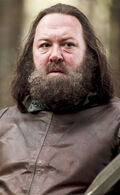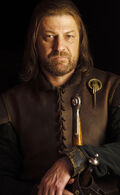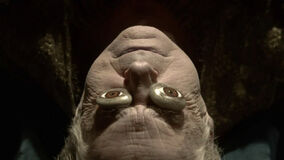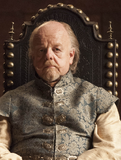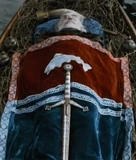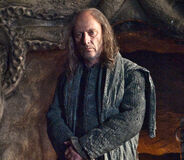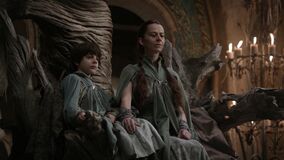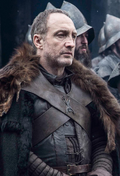
Territories and their rulers:
House Stark, the North (white);
House Arryn, the Vale of Arryn (navy blue);
House Frey, the Riverlands (dark blue);
House Greyjoy, the Iron Islands (gold);
House Lannister, the Westerlands (red), the Crownlands (brown);
None, the Reach (green);
Unknown (possibly House Lannister), the Stormlands (yellow);
None, Dorne (orange);
Night King, Beyond the Wall (sky blue);
Lord Commander of the Night's Watch, the Gift and the Wall (black)
The Great Houses are the most powerful of the noble houses of the Seven Kingdoms. They exercise immense authority and power over their vassals and territories and are answerable only to the King of the Andals and the First Men.
Before the Targaryen Conquest, each of the Seven Kingdoms was ruled independently by a powerful royal family. During the Conquest these families were either destroyed, replaced, or defeated and made to swear allegiance to King Aegon, who reigned from the Iron Throne in King's Landing.
The Gardeners, Hoares, and Durrandons were slain and replaced by the Tyrells, Greyjoys, and Baratheons respectively, while the Lannisters, Arryns, and Starks surrendered peacefully and were allowed to remain in control of their lands. In addition, Aegon raised up the Tullys to rule over the Riverlands, which had been under Ironborn occupation prior to his arrival. Only House Martell of Dorne resisted his armies, but was later brought into the fold through a peaceful marriage-alliance some two centuries later.
Each Great House has a large number of vassal houses serving it, most of whom in turn have smaller vassals under them, extending all the way down to farmers and landed knights. Each Great House rules over its territory and is responsible for collecting taxes and, in times of war, raising troops to fight for the king. Otherwise they are largely left to operate autonomously to simplify the bureaucracy and governance of the realm.
Robert's Rebellion ended in the exile of the last Targaryens, with House Baratheon replacing them on the Iron Throne, forming the royal cadet branch House Baratheon of King's Landing.
The War of the Five Kings has seen changes amongst the Great Houses. House Martell and House Baratheon, including all three of its rival branches, have become extinct, presumably alongside House Tyrell. The Riverlands and the titles of House Tully, which is also near extinction, defeated in the war and exiled, have been given to its usurping former vassals House Frey, though the other Tully vassals remain opposed to the Freys, whose male line has, meanwhile, been effectively wiped out. With the coronation of Queen Cersei I Lannister, the Crownlands are now held by House Lannister, the new de facto royal house after the extinction of the Baratheons. Although scattered early in the war and stripped of lands and titles, House Stark has regained control of the North through the defeat of its usurping vassals House Bolton.
The Great Houses
Current Great Houses
- House Arryn - rulers of the Vale of Arryn from the castle of the Eyrie. It was integrated with the Kingdom of the North until King Jon Snow abdicated, though it still holds allegiance to House Stark. Its current head is Lord Robin Arryn.
- House Greyjoy - rulers of the Iron Islands from the castle of Pyke. Divided, with members supporting either the Lannister or Stark/Targaryen cause. Its leadership is currently disputed by King Euron Greyjoy and claimant Lady Yara Greyjoy.
- House Lannister - the current royal house of the Seven Kingdoms from the Red Keep of King's Landing in the Crownlands and rulers of the Westerlands from the castle of Casterly Rock. Its leadership is currently disputed by Queen Cersei I Lannister and Lord Tyrion Lannister.
- House Stark - rulers of the North from the castle of Winterfell. Recently retook their lands from House Bolton, and currently preparing for the war against the Night King. Its current head is Lady Sansa Stark, who jointly rules the North with Warden Jon Snow.
- House Targaryen - claimant royal house of the Seven Kingdoms, former royal house and rulers of the Crownlands from the castle of the Red Keep. Currently based at Dragonstone and preparing for war against the Night King. Its current head is claimant Queen Daenerys I Targaryen but as the last legitimate living son of Prince Rhaegar Targaryen, Jon Snow is its rightful head.
Former Great Houses
- House Tully - the former rulers of the Riverlands, ruling from Riverrun, until the Red Wedding. Riverrun is currently under House Lannister's control. Its current head is Edmure Tully, who remains a captive of House Lannister.
- House Frey - former vassals to House Tully, rulers of the Riverlands from the castle of Riverrun after usurping their positions as a result of the Red Wedding. Lord Walder Frey and all of his sons were murdered by Princess Arya Stark, leaving its lordship uncertain and briefly descending the Riverlands into anarchy, until Lannister soldiers were sent to maintain order. While there may still be some Freys left in Westeros (Walder Frey had a lot of children and made a lot of alliances through marriage), the house is functionally dead.
Extinct Great Houses
Nine Great Houses have gone extinct, three of which were as a result of their defeat in the Targaryen Conquest, four of which as a result of the War of the Five Kings:
- House Casterly - rulers of the Westerlands until they were swayed away from their home by the legendary trickster Lann the Clever, the founder of House Lannister.
- House Mudd - rulers of the Riverlands until their bloodline was extinguished by Andal invaders.
- House Justman - rulers of the Riverlands until they were exterminated by House Durrandon.
- House Hoare - rulers of the Iron Islands and (through conquest) the Riverlands. After their defeat, Aegon the Conqueror commanded the ironborn to select a new family from among their number to rule over the rest, under the Targaryens. They selected House Greyjoy.
- House Durrandon - rulers of the Stormlands. Orys Baratheon, the founder of House Baratheon, married the daughter of the last king of House Durrandon, thus House Baratheon descends from the Durrandons through the female line.
- House Gardener - rulers of the Reach. House Tyrell claims descent from House Gardener through the female line, and House Florent is actually a cadet branch of House Gardener, with a better claim to rule based on lineage than the Tyrells. Several other Houses from the Reach also descend from House Gardener.
- House Baratheon - rulers of the Crownlands and Stormlands from the Red Keep and Storm's End, respectively. Extinct in actuality due to all mainline members being deceased but the bloodline is still alive, technically speaking, through Robert the Usurper's many bastard children. The line legally ended with the death of King Tommen I Baratheon, the bastard son of twins Queen Cersei Lannister and Ser Jaime Lannister, who was legally the last remaining Baratheon.
- House Baratheon of Storm's End - rulers of the Stormlands from the castle of Storm's End, claiming the Iron Throne. This branch of House Baratheon formally ended with the death of claimant King Renly Baratheon after he was murdered by his brother, Stannis.
- House Baratheon of Dragonstone - rulers of the Stormlands from the castle of Dragonstone, claiming the Iron Throne. Extinct as of the Battle of Winterfell and the death of claimant King Stannis Baratheon.
- House Baratheon of King's Landing - rulers of the Crownlands from the castle of the Red Keep in King's Landing, and the former royal house. Extinct as of King Tommen's suicide following the destruction of the Great Sept of Baelor.
- House Martell - rulers of Dorne from the castle of Sunspear. Wiped out by Ellaria Sand and three of the Sand Snakes in their coup, though due to the five remaining Sand Snakes being bastard children to Prince Oberyn Martell, the bloodline is technically still alive.
- House Bolton - former vassals to House Stark, rulers of the North from the castle of Winterfell after usurping their positions from House Stark during the Red Wedding. Ramsay Bolton, the sole heir, was killed in the aftermath of the Battle of the Bastards by his own hounds, rendering the house extinct.
- House Tyrell - rulers of the Reach from the castle of Highgarden after the extinction of House Gardener. The bloodline is wiped out during the Destruction of the Great Sept of Baelor and the Sack of Highgarden.
Heads of the Great Houses
Heads of Great Houses at the beginning of the TV series
Just prior to the death of Lord Hand Jon Arryn, which set the narrative in motion, the original heads of the Great Houses in the Seven Kingdoms were:
Heads of Great Houses after the Red Wedding
House Bolton and House Frey were elevated to Great House status after the betrayal at the Red Wedding, which they switched from the Stark side to the Lannister side in the war. The Lannisters rewarded them by naming the Boltons as the new rulers of the North (displacing the Starks) and the Freys as the new rulers of the Riverlands (displacing the Tullys).
Edmure Tully was already the functional leader of House Tully for several years prior to the start of the narrative due to his father's old age and failing health, and became the official head of House Tully upon his father's death at the beginning of Season 3.
House Stark was scattered after the Red Wedding with survivors fleeing into exile or assumed dead, and thus was left with no clear leader as a faction after the Red Wedding.
Current heads of Great Houses
Of the nine characters who were the heads of Great Houses at the beginning of the TV series, by the end of Season 6 none remain alive.
More broadly, Robin Arryn, Edmure Tully, and Walder Frey might be included in this count: Robin's father Jon Arryn died right before the first episode, though his rule is only nominal given that he is underaged, intellectually stunted, and a succession of regents have actually "led" House Arryn on his behalf. Edmure, meanwhile, was the acting head of House Tully for several years prior to the beginning of the TV series due to his father Hoster's health declining to the point that he was bedridden: Edmure became the official head of House Tully upon his father's death, but was later captured by Frey/Lannister forces. Walder Frey has remained the head of his own family since the beginning of the narrative, but the Freys were only promoted to Great House status after the Red Wedding. For that matter, Olenna Tyrell was always the de facto leader of House Tyrell.
With the deaths of both Mace Tyrell and Walder Frey in the Season 6 finale, none of the Great Houses are still led by their rulers at the beginning of the TV series. Even compared to the middle of Season 1, the only ones still alive are those who didn't actually hold the title but functionally ruled (Edmure) or who technically held the title but didn't actually rule (Robin).
In the books
In the A Song of Ice and Fire novels, the term "great house" or "ruling house" is used informally. Author George R.R. Martin has said that in retrospect he should have used a formal senior rank to differentiate the ruling houses from their vassals.
Keeping in mind that Martin has said that Westeros is roughly the size of the continent of South America, the realm known as "the Seven Kingdoms" spans an area on the scale of the Roman Empire. Thus in terms of their populations and the size of the armies they can raise in wartime, each of the "Great Houses" is more comparable in scale to a real-life medieval kingship like England or France than a smaller dukedom. Provinces (in this case, constiutent regions) are in effect semi-autonomous with the local people regarding the local Great House as their rulers, and the King as perhaps an abstract and distant figure who has no bearing on their day-to-day lives.
The definition of a "Great House" in general can be summarized as any noble House that bends the knee directly to the Iron Throne and rules one of constituent regions of the realm. The royal family itself rules the Crownlands directly, loosely making it another Great House, though technically it ranks higher than all the others. At the start of the books this list comprises the Starks, Lannisters, Arryns, Greyjoys, Tullys, Tyrells, Baratheons of Storm's End, and Martells. This definition sometimes leads to oddities, for example, House Hightower of Oldtown commands a vastly populous city (second only to King's Landing and not by much) and an immense area of territory around it, including numerous smaller vassal houses. The Hightowers could theoretically be more powerful than the ruling Great House of less populous regions (such as the Greyjoys and perhaps even the Martells), but as they are vassals of the Tyrells, they are not counted as a Great House.
Few Great Houses have ever gone extinct. By the time the books begin, only three former Great Houses have ever been destroyed, all during the Targaryen Conquest, three hundred years before the War of the Five Kings:
- House Durrandon - rulers of the Stormlands.
- House Gardener - rulers of the Reach.
- House Hoare - rulers of the Iron Islands and (through conquest) the Riverlands.
After the Targaryen Conquest, House Baratheon replaced the Storm Kings of House Durrandon, House Tyrell replaced House Gardener, and House Greyjoy replaced House Hoare. Orys Baratheon, the founder of House Baratheon, married the daughter of the last Storm King, so there was some continuity with the former House and its replacement. House Durrandon left no other known branches besides the Baratheons. House Gardener intermarried with many of the great noble families of the Reach, and House Florent is even a cadet branch of the main Gardener line. House Tyrell descends from House Gardener through the female line (much to the consternation of the Florents), so there is some continuity in the Reach as well. Thus, by the time of Robert's Rebellion, the Reach is the only region of Westeros which has noble Houses with rival claims to rule based on descent.
When Harren Hoare and all of his sons were roasted alive by Aegon the Conqueror's dragons, he had the ironborn choose one of their own Houses to rule over them (under the overall rule of the Targaryens), and they chose House Greyjoy. The Iron Islands are actually something of an odd case, in that for many centuries their kingship was not hereditary. When a king died, the powerful noble Houses of the Iron Islands would meet in an assembly known as a Kingsmoot to select a new king to rule over all of them. Five thousand years ago, House Greyiron killed all of the representatives at the last Kingsmoot, and ruled the Iron Islands as hereditary kings for a thousand years. The Greyirons were destroyed four thousand years ago during the Andal Invasion, when they were deposed by House Hoare. Whether the Greyirons should be considered a Great House that early in history is unclear.
House Hoare officially went extinct when Harren died, but it only went extinct in the male-line. House Volmark, an ironborn noble family from Harlaw, descends from House Hoare through the female line (much as House Tyrell descends from the officially extinct House Gardener through the female line). House Volmark never had particularly strong claim against House Greyjoy, however, due to a combination of that the ironborn are very misogynistic and don't place much value on female-line descent, and because of the unusual elected-kingship customs of the Iron Islands.
Nonetheless, no noble House from the Iron Islands can claim a better right to rule than House Greyjoy based on descent: multiple houses from the Iron Islands, including House Greyjoy, possess ancestors who were kings, but during the time of the non-hereditary kingship based on elections in the kingsmoot. Moreover, the Greyjoys were at least briefly kings during the Greyjoy Rebellion, so by the time of the War of the Five Kings, they are still held in very high esteem by the ironborn. Thus the situation in the Reach is still unique, with other noble Houses besides the current Great House possessing claims to rule based on descent, and specifically House Florent actually has a better claim than House Tyrell based on descent.
In ancient times, other royal Houses included House Greyiron in the Iron Islands, House Mudd - whose domain was located along the Blue Fork of the Trident and ruled as Kings of the Rivers and the Hills, House Fisher - which also ruled the Riverlands as River Kings, House Teague also in the Riverlands, and House Casterly in the Westerlands. However, given that at that time almost every castle in Westeros commanded a kingdom and almost every lord (great or not) called himself a king, it is unclear whether or not these houses should truly be called "Great".
It is notable that, in the books, House Frey was never made a great house: they were awarded Riverrun but not the power that comes with it, and Harrenhal was made the new seat of power in the Riverlands (making House Baelish the de jure Great House of this region). When Jaime Lannister arrives at the second siege of Riverrun (depicted in Season 6 of the TV series), in the books he is disgusted with the Freys and slights them by explicitly pointing out that they were not named the new Lords Paramount of the Riverlands, technically Littlefinger holds the title. Nevertheless, the Freys functionally claim authority over Riverlands, exploiting Petyr Baelish's lack of attention to his new lands.
See also
Template:Great Houses navbox

